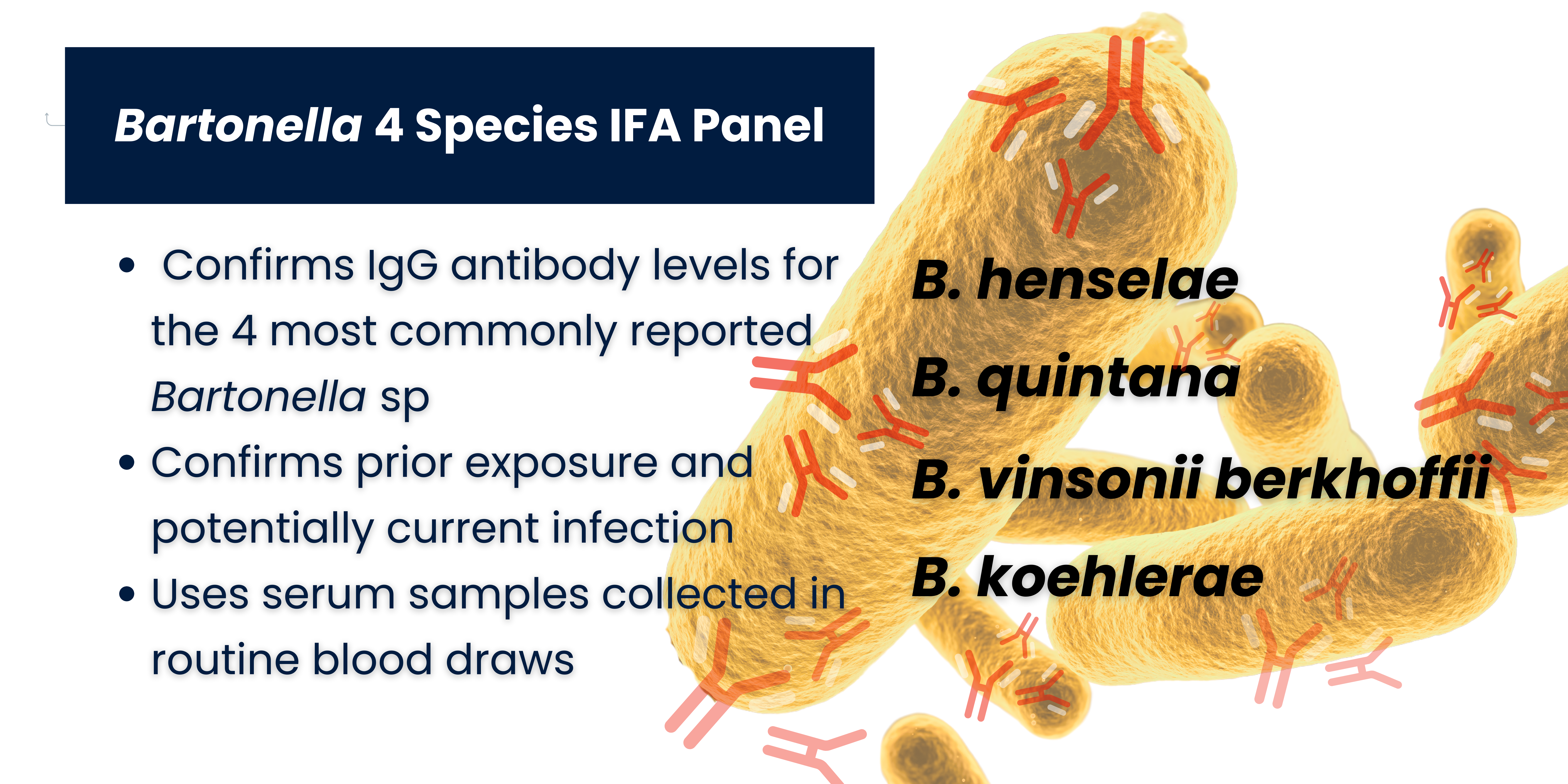Our Bartonella IgG IFA Serology Panel provides the broadest antibody detection available, confirming exposure to the four species most commonly associated with disease in people, dogs and cats. These four Bartonella species—B. henselae, B. quintana, B. vinsonii berkhoffi, and B. koehlerae–are also the most commonly reported species in DNA prevalence studies in people, animals, and vectors.

When bacteria are present in the body, the immune system creates antibodies that help eliminate them. Test methods, such as immunofluorescence assays (IFA), determine the level of IgM and/or IgG antibodies circulating in a patient, which can be useful for the diagnosis of bartonellosis (Bartonella spp infection), especially for monitoring treatment response.
Over 20 Bartonella species have been implicated in human and animal diseases. The most commonly reported species have been implicated in systemic diseases affecting the heart, central nervous system, eyes, bones, and joints.
Four Most Common Species of Infection
Bartonella henselae
The causative agent of cat scratch disease, B. henselae has been documented in people and animals worldwide. Transmission is thought to occur primarily in the context of contact with cats and fleas. Transmission by needlestick, tick bite, spider bite, and contact with lice has also been reported in the medical literature.
Bartonella quintana
The causative agent of trench fever, B. quintana has been documented worldwide in people who live outdoors in rough settings with poor hygiene. Transmission is thought to occur primarily through contact with rodents and body lice.
Bartonella vinsonii berkhoffii
Documented most often in veterinary workers, B. vinsonii berkhoffii infection has been documented worldwide in people who live and work with animals and can lead to systemic diseases. Transmission is thought to occur primarily in the context of contact with dogs and fleas.
Bartonella koehlerae
A more recently discovered species associated with cat contact, B. koehlerae has been implicated in illnesses impacting the central nervous system in people. As for B. henselae, transmission is thought to occur primarily in association with cats and fleas. Commercial testing for this species is only available at Galaxy Diagnostics at this time.
Test Recommendations
To ensure the highest levels of sensitivity and specificity, we use cell-culture-derived antigens derived from patient isolates. In fact, our Bartonella IgG Detect – IFA Serology test shows very high specificity for these four Bartonella species that most commonly affect cats, dogs, and people. A 2020 NCSU study showed a specificity of 97% for B. henselae, B. vinsonii berkhoffii, and B. koehlerae in nearly 16,000 dogs that were suspected of having a vector-borne infection.
Along with a growing community of medical researchers worldwide, we recommend maximizing diagnostic data by testing for both antibodies and DNA evidence of infection.
Bartonella are elusive bacteria, evading immune response by hiding in cells and tissue. Based on NCSU research studies, many patients with detectable Bartonella spp DNA never develop detectable antibodies, while others may only show very low titers.
Learn more about when and why to order Bartonella IFA Serology testing from our Chief Scientific Officer, Ed Breitschwerdt, DVM, DACVIM, globally recognized as a leading expert on bartonellosis and other vector borne infections.
FAQS
Which species can the Bartonella IgG panel detect?
The panel confirms exposure to the four species most commonly associated with disease in people, dogs and cats. These four Bartonella species—B. henselae, B. quintana, B. vinsonii berkhoffii, and B. koehlerae–are also the most commonly reported species in DNA prevalence studies in people, animals, and vectors.
How does this compare to the BBB Direct Detect?
The BBB Direct Detect platform detects active infection on a genus-level for three pathogens: Bartonella, Borrelia, and Babesia. The BBB detects active Bartonella pathogens by using a DNA-based approach. It employs specialized culturing and enhanced digital PCR to increase bacterial load, making detection ten times more sensitive than traditional PCR. It directly detects Bartonella [plus Borrelia and Babesia] species on a genus-level without differentiating between them.
The Bartonella IgG Detect – IFA indirectly measures antibody levels (IgG) through quantitative serology to confirm prior exposure. It differentiates between the four most common species of Bartonella in people, dogs, and cats. Determining the presence of antibodies in a patient can be useful for the diagnosis of Bartonellosis, and especially for monitoring treatment response.
Testing both antibodies and DNA maximizes diagnostic accuracy, as Bartonella is a stealth pathogen and can evade the immune system. Some patients with detectable Bartonella DNA never develop antibodies, or only show low titers. Some patients evade immune response and will only have detectable DNA evidence.
Can the serum samples be stored?
We recommend shipping the samples the same day they are collected if possible. The serum can be stored in the refrigerator, but must reach our lab and begin testing within two weeks of original collection.
Please see our Specimen Collection Instructions for details.


